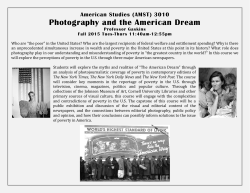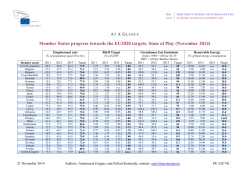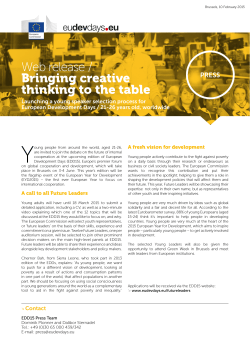
143.34 KB - European Institute for Gender Equality
Beijing+20: The Platform for Action (BPfA) and the European Union Area A: Women and Poverty Policy Context Poverty is a complex, multi-dimensional problem that goes beyond a basic lack of resources for survival and extends to the deprivation of civil, social and cultural activities, as well as opportunities for political engagement and social mobility (Council of the EU, 2007). Women receive lower income compared to men, placing them at a greater risk of poverty. The Europe 2020 Strategy • Aims at delivering smart, sustainable and inclusive growth in the EU through job creation and poverty reduction. A.1. Review, adopt and maintain macroeconomic policies and development strategies that address the needs and efforts of women in poverty. A.2. Revise laws and administrative practices to ensure women’s equal rights and access to economic re sources. A.3. Provide women with access to savings and credit mechanisms and institutions. A.4. Develop gender-based methodologies and conduct research to address the feminisation of poverty. • Sets the headline target of lifting at least 20 million people out of poverty and social exclusion by 2020. The database, Women and men in the EU — facts and figures, developed by the European Institute for Gender Equality provides the latest data and information on these indicators, available at: The European platform against poverty and social exclusion http://eige.europa.eu/content/women-and-men-inthe-eu-facts-and-figures • One of seven flagship initiatives of Europe 2020 is one of the key instruments to protect and promote women’s social inclusion. It applies gender mainstreaming to its key initiatives such as the promotion of equal economic independence, the assessment of gaps in entitlements to family-related leave and the monitoring of the transposition of existing directives related to family leave entitlements. European Pact for Gender Equality (2011-20) • Reaffirms the Council’s commitment to fulfil EU ambitions on gender equality, especially in three areas relevant to gender equality: namely employment, education and promoting social inclusion in particular through the reduction of poverty. The strategic objectives of the BPfA and the EU indicators In 2007, the Council agreed on three EU-wide indicators including two sub-indicators to measure the progress in the EU on the implementation of the BPfA objectives. They look at the at-risk-of-poverty rate by age, sex and type of household, including lone parents with dependent children and at inactivity rates by age and sex. Findings from EU-wide data The at risk of poverty rate increased In 2012, 17 % of the population in EU was at risk of poverty, with women at a slightly higher risk of poverty than men. This is partly explained by the fact that, across Europe, women receive lower pay and work in poorer working conditions than men, and they are more likely to be in part-time work, have fixed-term contracts or to have care-related absences from the work force. Along with a slight rise in risk of poverty for both women and men (up 0.2 p.p.) since 2007, the gender gap has narrowed to just over 1 % in 2012. If the average increase is moderate in the EU, there is however a significant increase in risk of poverty in two-thirds of the Member States, particularly in those hardest hit by the crisis. The measure of risk of poverty is relative to median earnings. As a result, it may fail to fully take into account the level of poverty in Member States where there has been a fall in incomes. PERCENTAGE OF WOMEN AND MEN LIVING IN POVERTY IN THE EU, 2007 – 12 Women Men € 15612 Median income € 14287 € 14894 € 13509 € 9367 Poverty line (60 % of median) € 8572 € 8936 € 8105 17% 15% 2007 17% 15% 2008 17% 15% 2009 17% 15% 2010 17% 16% 2011 17% 16% Percentage of persons living in poverty 2012 Source: Eurostat, EU-SILC Age is a significant factor for being at risk of poverty Being single, or especially a lone parent, increases the risk of poverty Young people aged 16-24 are at greatest risk of poverty (24 % in 2012 in the EU), which has increased since 2007 in the majority of the Member States. Young women of this age group are more likely to be at risk of poverty (gender gap of 1.6 p.p. in 2012), which represents a slightly higher gender gap than that of the entire population. Across the EU, 25 % of single people were at risk of poverty with single women slightly more at risk of poverty than men (26 % to 25 %) in 2012. The gender gap of those at risk of poverty has narrowed since 2007, influenced largely by a worsening situation among single men (from 22 % in 2007 to 25 % in 2012), particularly within ten Member States. The at-risk-of-poverty rate of women aged 25 to 49 - the key child raising years - exceeds that of men in 19 EU Member States, while differences between women and men are relatively small in the EU overall. The risk of poverty appears once there are dependent children in the household and increases with an increased number of dependent children. In 2012, the at-risk-of-poverty rate among lone parents, most of whom are women, reached 34 % and continued to place lone parents at a higher risk of poverty compared to single persons without dependents. Many lone parents have to combine parenting and childcare with employment which may lead to more precarious, low-paid employment with a lower level of social protection. Lower income for women as indicated by the gender pay gap, makes lone mothers/ carers more exposed to poverty. Age is associated with a growing gender gap in being at risk of poverty. Elderly women (over 65) are much more at risk of poverty than elderly men (16 % compared with 12 % in 2012). More than half of the 28 Member States (17) have gender gaps in pensions larger than 30 % (39 % in the EU). This large gender gap can be attributed to the combined effect of women’s lower lifetime earnings and smaller or interrupted social security contributions related to the gender pay gap, greater prevalence of parttime working and interrupted social security contributions during pregnancy and due to caring responsibilities. Some groups of women in the EU are particularly exposed to poverty, such as lone mothers, ethnic minority women, migrant women, younger and elderly women. These groups need the adoption of special measures addressing poverty. MAIN REASON FOR WOMEN AND MEN AGED 15 – 64 NOT TO SEEK EMPLOYMENT IN THE EU, 2012 Women Men 41% 27% 26% 12% 18% 18% 6% 3% Own illnes or disability Family, peronal or care reasons In education 24% 5% Think no work is available Retired 12% 8% Other Source: Eurostat, EU-SILC Women’s lower economic activity is a significant factor for being at risk of poverty Proportionally more women than men are economically inactive across the Member States. Since 2007, the proportion of economically inactive women and men aged 15 to 64 years decreased in the Member States. This decrease was higher for women, reducing in part the gender inactivity gap at EU level for that period. Nevertheless, the proportion of inactive women in 2012 was still considerably higher than that of men and women were at least six times more likely than men to be inactive due to caring or other family responsibilities. Employment is crucial for the economic independence of women and men. Inactivity and interrupted employment patterns increase the risk of poverty for women. Women are more likely to face economic dependence and their career patterns may lead to lower level of income and social protection later in life. Findings from EIGE’s work on good practices: Rural Woman: Employment and New Technologies — Spain The Rural woman: employment and new technologies project involves eight local action groups in five Spanish regions — Andalusia, Asturias, Castilla-La Mancha, Castilla y León and Madrid. The initiative promoted women’s entrepreneurial and social economy initiatives (cooperatives, worker-owned companies and partnerships) using ICT. The participants were women in rural areas aged between 20 and 60. The project paid special attention to young women, involved in informal activities. The project’s main achievement has been to support around 1 000 women, run 11 training courses for 833 of them, and set up 43 new companies. Goldrausch — Germany Goldrausch Frauennetzwerk is a small non-governmental association operating in Berlin area since 1982. Its objective is to help business women in Berlin to set up and invest in their own businesses by giving interest-free microloans. In recent years preference has been given to women aged over 45 and with a migrant background. All beneficiaries run one-person enterprises, most of them of the service sector, such as cosmetics, restaurants, biologists, retail shops, bakeries and childcare services. Between 1982 and 2007 Goldrausch distributed some EUR 850 000 to more than 450 business women and projects in Berlin. Between September 2010 and 2013, Goldrausch allocated 70 loans totalling EUR 240 000. Its default rate is a remarkably low 1.3 %. ADVANCEMENTS AND OBSTACLES IN AREA A: WOMEN AND POVERTY ADVANCEMENTS OBSTACLES • Increasingly more women are economically active. • Women remain consistently more likely to be living at risk of poverty than men. • A n overall narrowing in the gender gap in economically inactive populations. • The poverty risk for lone parent households has increased in the EU and women are still disproportionately represented amongst loneparent households. • L one mothers and marginalised groups of women receive extra support and resources. • R eforms in pension arrangements to accommodate the different patterns of women’s and men’s careers. • Women are still much more likely to be economically inactive than men due to family care responsibilities. • Inactivity and interrupted employment patterns increase the risk of women in poverty. The way forward for the EU • Reinforce measures which support gender equality in economic activity. • Mainstream gender within economic development initiatives. • Promote equality in employment to achieve equal economic independence and financial security. • Support initiatives that increase awareness of the importance of women’s economic independence for poverty reduction. • Address the effects of interrupted careers and different working patterns, such as part-time employment, on women’s risk of poverty throughout the life-course. • Develop targeted policy measures to specific groups of women who are most at risk of poverty such as younger/elderly women or lone parents. • Continue to reform the national pension arrangements by taking into account the gender dimension in pension entitlements. • Address child poverty by including a gender perspective and a holistic approach that develops synergies between social inclusion and other policy areas (such as education, employment and gender equality, health, housing and living environment) and with other instruments (such as EU funding programmes). European Institute for Gender Equality (EIGE) The European Institute for Gender Equality (EIGE) is the EU knowledge centre on gender equality. EIGE supports policy-makers and all relevant institutions in their efforts to make equality between women and men a reality for all Europeans and beyond by providing them with specific expertise and comparable and reliable data on gender equality in Europe. More information: http://eige.europe.eu The Resource and Documentation Centre (RDC) of the European Institute for Gender Equality is an innovative and practical tool developed to assist in locating key resources on gender equality, to facilitate the exchange of knowledge among those with an interest in gender equality policies and practices and to offer an online space for discussion and debate. More information: http://eige.europa.eu/content/rdc facebook.com/eige.europa.eu Contact information: European Institute for Gender Equality Gedimino pr. 16, LT-01103 Vilnius, LITHUANIA Tel. +370 5 215 7444, Tel. +370 5 215 7400 twitter.com/eurogender youtube.com/eurogender https://eurogender.eige.europa.eu ISBN: 978-92-9218-560-2 doi: 10.2839/65428 MH-04-15-022-EN-C
© Copyright 2025










